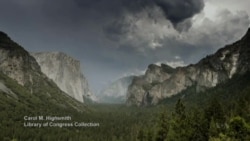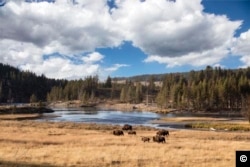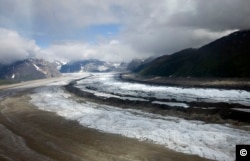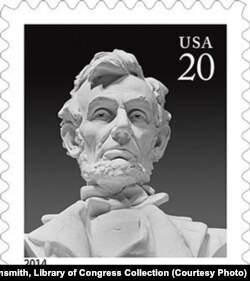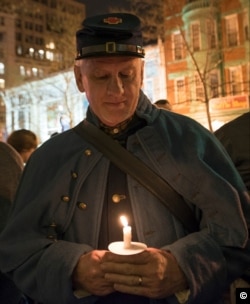Imagine the fun — and the responsibility — of photographing America.
That’s what Carol M. Highsmith has been doing for more than three decades — traveling the U.S. and taking pictures of the people and places that make America unique.
The award-winning photographer shoots everything from small family farms to historic landmarks to stunning landscapes of America’s national parks, plus many other cultural and historic sites.
Highsmith wants to capture as many images as she can before those places change or disappear, she said. And she’s donating her photos to the Library of Congress in Washington, the largest library in the world, completely royalty free.
What better place for them to be stored, she said, than at the nation’s library? It's a place that, as she put it, "knows all about preservation.”
“When I go out across America, what do I photograph? Everything! Someone said to me, ‘Well, why would you photograph the Golden Gate Bridge, for instance. Everybody's taking photographs of it.’ Yes, there will be images of the Golden Gate Bridge that may exist 500 years from now, but the ones that we know will exist in high resolution will be mine at the Library of Congress," Highsmith said.
IN PHOTOS: Renowned Photographer Captures America’s Treasures in Stunning Images
“Not that I'm such great shakes. It's just that they need to be tucked somewhere for us so that we can see what we looked like during this time period," she added.
Frances Benjamin Johnston
Highsmith was inspired to embark on her project by another patriotic American, Frances Benjamin Johnston, a photographer who traveled across the country 100 years ago.
“When I visited the Library of Congress, I saw the work of Frances Benjamin Johnston,” Highsmith said. “And she had donated her work royalty free, and so I thought ‘That's what I'll do. I'll donate my work, royalty free.’”
And that’s exactly what she’s doing.
“I had the thrill of going to Yellowstone [National Park], where Frances Benjamin Johnston had gone 100 years ago, at a time when you could just go up to the geysers and look straight down — didn't matter that it might have blown your face off,” she said with a laugh.
Johnston had taken a self-portrait there, Highsmith said, so she decided she’d like to have one taken there, too. She wrote to the park ranger and asked if he could find that exact spot, and after a bit of searching, apparently he did.
“So I did it!” said Highsmith, proudly, “it was such a thrill to sit where she sat!”
Natural wonders
In addition to the thrill of sitting in the same spot as Johnston had a century before, Highsmith also enjoyed capturing the many natural wonders of Yellowstone. Located in Wyoming, the park has the world's largest collection of geysers and spectacular vistas that look different in every season.
Highsmith took many photographs of the park during those changing seasons, and she became particularly fond of its resident bison.
“So you're looking at this vast, gorgeous landscape of Yellowstone, in the winter, in the fall and the spring, and you're seeing the bison babies, the calves and you just think, 'Will this always be?' ” she said.
“I would say in all the wildlife images I’ve taken, and I’ve taken a lot, the bison are the best, in a sense that they look like they come from a hundred thousand years ago.”
Capturing the present
Highsmith shoots at all hours of the day, in every weather condition, and has even had to face her fear of flying.
“So I finally get to Alaska and I'm going to Denali [National Park], and I hire a plane to take me up there and I'm thinking all the way there, ‘How can I get out of this?’ I just say, ‘You must do it.' So I did it!" she recalled. “But to photograph it, and then to photograph Ruth Glacier, which is huge, and to know that maybe someday it'll be gone — it was just an experience and a half!”
It is that fear of iconic American landscapes and landmarks one day disappearing that motivates her.
“They say Yellowstone could have an earthquake, it could have a volcano, it could just blow up,” she said. “You don’t know, I don't know, we don’t know where history will take us.
“And the Washington Monument. We had an earthquake here in Washington, D.C. That whole thing could have just collapsed. So I'm just there to capture it as it looks right now.”
Postage stamps
Two of Highsmith’s photographs have ended up on U.S. postage stamps, both Washington landmarks honoring past presidents: the Lincoln Memorial and the Jefferson Memorial.
“That was a thrill, you know, to know your images are traveling all over the world,” Highsmith said.
And there have been other experiences, she said, that have been meaningful for her.
Connecting with history
“So I'm at Ford's Theatre, 150 years after Lincoln died, right there. And there are re-enactors, and there was this man who held a candle and that's how his face was lit. And I thought, ‘Whoa, you could almost feel like what it must have felt like to be there that night,' ” she said.
“I also photographed, for instance, the coat that Lincoln wore the night he died, with his bloodstains on it. So to be close to these artifacts — it’s just incredible."
“Do I not get that there are millions and billions of photographs being taken every day?” Highsmith asked rhetorically. “I do. But unfortunately, most of those won’t be around over time.”
So she said that for the Library of Congress to preserve her images, and those of Frances Benjamin Johnston and others who came before her, "is an honor.”
"I'm just glad to be there," she said proudly. "I'm glad to have this as my job.”




